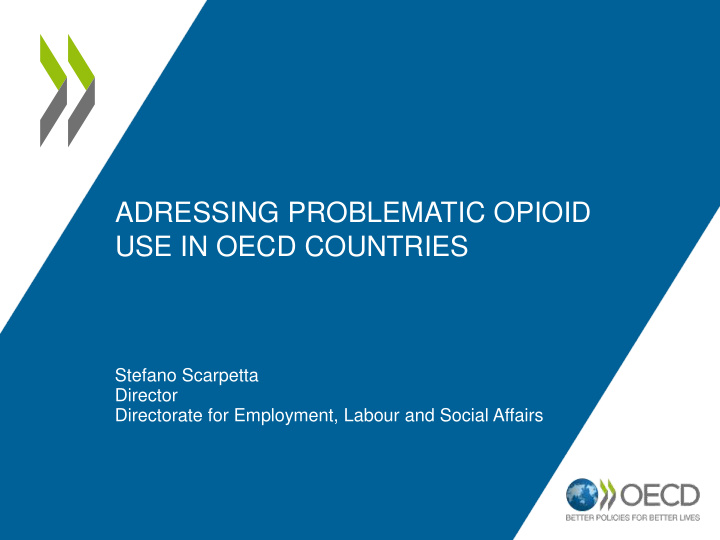



ADRESSING PROBLEMATIC OPIOID USE IN OECD COUNTRIES Stefano Scarpetta Director Directorate for Employment, Labour and Social Affairs
Opioid-related deaths have grown by 20% since 2011 Opioid-related deaths per million inhabitants, 25 OECD countries, 2011-2016 (or latest available) 2011 2016 or latest Opioid-related deaths per million inhabitants 140 120 100 80 60 40 20 0 Note : Countries ranked by latest year with available information. Source : EMCDDA and country contributions.
Four main factors fuelling the opioid crisis Opioids prescription and over-prescription in health systems • Uncorroborated claims of prescription opioids safety and risks • Opioid manufacturers’ influence • Poor opioid prescribing practices and insufficient education • Insufficient alternatives for pain management Dynamic illicit market of opioids • Availability of low cost and high purity illicit opioids • Polysubstance use and abuse • Prison post-release period Treatment of opioid use disorder patients Macroeconomic and social conditions
Both prescription and illegal opioids contribute to the crisis Ille Illegal opioid ids Prescription opio ioids • • Opioid use is fuelled by illicit They are used in the therapy of markets. moderate to severe pain, palliative care and opioid use disorders. • Heroin has been the most • prevalent illicit opioid worldwide. Over-prescription and misuse can lead to abuse and dependence. • Recently, much stronger analogues have taken the scene. Carfentanil that can be 10,000 times stronger than morphine.
Availability of analgesic opioids grew almost 110% in the 2000s Mean availability of analgesic opioids in OECD countries 2011-2016. S-DDDs per million inhabitants per day 2011-13 2014-16 S-DDDs per million inhabitants per day 45000 40000 35000 30000 25000 20000 15000 10000 5000 0 Note : This does NOT include illicit opioids. Source : INCB 2018
The influence of the drug industry and distributors
Four main factors fuelling the opioid crisis Opioids prescription and over-prescription in health systems • Uncorroborated claims of prescription opioids safety and risks • Opioid manufacturers influence • Poor opioid prescribing practices and insufficient education • Insufficient alternatives for pain management Dynamic illicit market of opioids • Availability of low cost and high purity illicit opioids • Polysubstance use and abuse • Prison post-release period Treatment of opioid use disorder patients • Barriers to access medication assisted therapies • Predominance of abstinence-only rehabilitation therapies • Inadequate access to evidence-based harm minimisation interventions Macroeconomic and social conditions • Unemployment • Housing • Social exclusion • Stigma
Addressing problematic opioid use: 4 areas of policy action Health system Social policies actions Opioid id prevention an and control Information and Regulation and knowledge enforcement
Social support and medical treatment are most common areas of policy action 20 USA 18 SVN USA SWE SVN USA USA 16 NOR SWE SVN SVN LUX NOR SWE SWE USA 14 LTU LVA NOR NOR SVN Number of countries KOR LUX LVA LVA SWE USA 12 JPN LTU LUX LUX NOR SWE USA ITA ITA LTU KOR LVA NOR SVN 10 IRL IRL IRL ITA LTU LVA SWE FRA FRA FRA IRL JPN LUX NOR 8 EST EST EST FRA ITA ITA LVA NOR DEU DEU DEU EST IRL IRL JPN LUX 6 DEN DEN DEN DEU FRA EST IRL FRA CZE CZE CZE DEN DEU DEU DEU DEU 4 COL COL COL COL DEN DEN DEN DEN CHE CHE CHE CHE CZE CHE COL CHE 2 CAN CAN CAN CAN CAN CAN CAN CAN AUS AUS AUS AUS AUS AUS AUS AUS 0 Social Medical Needle/syringe Self-help and Clinical Disciplinary Stewardship Drug reintegration treatment programmes mutual aid guidelines actions for programmes consumption support groups physicians rooms overprescribing Note : Countries in alphabetical order within each category. National level implementation in dark blue, sub-national level of implementation in light blue Source : OECD 2018 survey on opioids control
Regulation and enforcement actions Identification of high risk shipments: • Registration of precursors Customs • Pre-load or pre-arrival air security • Open low-weight mail (30g or less in Canada) Medication • Inspection and education of regulated parties (e.g. storage) • diversion Prescription monitoring programmes • First responders (e.g. training, availability) Law enforcement • Public health perspective and promotion of interventions. officials • Internet monitoring with machine learning techniques • Drug treatment courts Criminal justice • Good Samaritan laws • Legal status of drug use and possession for personal system consumption
Better research is needed for pain relief Relatively small number of analgesic drugs approved in the last three decades Note : The timeline includes the main Mu opioid agonists, Acetaminophen, Nonsteroidal anti-inflammatory drugs (NSAIDs) approved by the F.D.A. (first approval date) and still marketed. The timeline does NOT include adjuvant analgesics or co-analgesics (e.g. anticonvulsants and tricyclic antidepressants) and local or topical anesthetics. Source : Authors’ elaboration on FDA and NCBI information.
In summary Opioid use disorders should be considered as a chronic health condition , guiding the design of both short- and long-term health system, social policy and law enforcement strategies. Better prescribing Better care Improving prescribing Expanding evidence-based MAT practices , limiting over- and harm minimisation with prescription and enhancing quality improvement and opioid-related literacy . measurement strategies. More co-ordinated approach Better knowledge & research Between health, social and Big data with advanced criminal justice systems , analytics , impact evaluations facilitating access to patient and R&D for pain and OUD care and support. care.
Thank you! Follow us on Twitter @OECD_social Visit our website www.oecd.org/health/opioids.htm
Recommend
More recommend